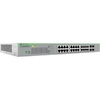-
Home
-
Contributors
-
International
-
Account
-
Information
More From Contributor
- 5 Gigabit Ethernet, 10 Gigabit Ethernet, ...
- 2 Layer Supported
- Twisted Pair
- Desktop, Rack-mountable, ...
- Gigabit Ethernet
- 10/100/1000 Base-T, 100/1000 ...
- 2 Layer Supported
- Modular
- Twisted Pair, ...
- 3 Layer Supported
- Modular
- Optical Fiber, Twisted ...
Allied Telesis FS980M/28DP - Managed L3 Fast Ethernet - PoE Switch
FS980M switches to join a protected ring, capable of recovery within as little as 50ms. This feature is perfect for high availability in enterprise networks - The FS980M Series provides static IPv4 routing at the edge of the network, as well as support for RIPv1 and RIPv2 - Create a VCStack of up to four units with 2 Gbps of stacking bandwidth per each unit. VCStack provides a highly-available system in which network resources are spread out across stacked units, minimizing the impact should any unit fail - PoE+ provides centralized power connection to media, cameras, IP phones and wireless access points - PoE+ reduces costs and offers greater flexibility with the capability to connect devices requiring more power (up to 30W), such as pan-tilt-zoom security cameras - PoE power
redundancy is available with a dual power supply model, to ensure critical powered devices remain online - The FS980M/28DP has dual power supplies to further increase reliability - The edge is the most vulnerable point of the network—the FS980M Series protects you with a full set of security features including Multi Supplicant Authentication, IEEE 802.1x, RADIUS, TACACS+, and Dynamic VLAN - Guest VLAN ensures visitors or unauthorized users can only connect to user-defined services—for example, Internet only - Access Control Lists (ACLs) enable inspection of incoming frames and classify them based on various criteria. Specific actions are applied to effectively manage the network traffic. Typically, ACLs are used as a security mechanism, either permitting or denying
entry
- External links may include paid for promotion
- Availability: In Stock
- Supplier: Ebuyer
- SKU: 1125843
Product Description
The FS980M/28DP features 24 x 10/100TX Po E+ ports, 4 x 100/1000X SFP uplink/stacking ports dual fixed PSU for power supply redundancy & 375W power budget. Centre COM FS980M/28DP switch is cost-effective, fully managed, & can be stacked for increased resiliency & port density at the edge of the network. As part of an Autonomous Management Framework™ (AMF) network, the FS980M/28DP switch utilise automated management & zero-touch recovery to lower running costs. Power over Ethernet delivers the full 30 watts of Po E+ to support video surveillance & wireless access applications with a power budget of 375W. Two fixed PSU provide both system & Po E redundancy. A single PSU is able to support the whole Po E+ budget.
- Ethernet Protection Switched Ring (EPSRing) allows several FS980M switches to join a protected ring, capable of recovery within as little as 50ms. This feature is perfect for high availability in enterprise networks
- The FS980M Series provides static IPv 4 routing at the edge of the network, as well as support for RIPv 1 & RIPv 2
- Create a VCStack of up to four units with 2 Gbps of stacking bandwidth per each unit. VCStack provides a highly-available system in which network resources are spread out across stacked units, minimizing the impact should any unit fail
- Po E+ provides centralized power connection to media, cameras, IP phones & wireless access points
- Po E+ reduces costs & offers greater flexibility with the capability to connect devices requiring more power (up to 30W), such as pan-tilt-zoom security cameras
- Po E power redundancy is available with a dual power supply model, to ensure critical powered devices remain online
- The FS980M/28DP has dual power supplies to further increase reliability
- The edge is the most vulnerable point of the network—the FS980M Series protects you with a full set of security features including Multi Supplicant Authentication, IEEE 802.1x, RADIUS, TACACS+, & Dynamic VLAN
- Guest VLAN ensures visitors or unauthorized users can only connect to user-defined services—for example, Internet only
- Access Control Lists (ACLs) enable inspection of incoming frames & classify them based on various criteria. Specific actions are applied to effectively manage the network traffic. Typically, ACLs are used as a security mechanism, either permitting or denying entry
Reviews/Comments
Add New
Intelligent Comparison
We couldn't find anything!
Perhaps this product's unique.... Or perhaps we are still looking for comparisons!
Click to bump this page and we'll hurry up.
Price History
Vouchers
Do you know a voucher code for this product or supplier? Add it to Insights for others to use.


 United Kingdom
United Kingdom
 France
France
 Germany
Germany
 Netherlands
Netherlands
 Sweden
Sweden
 USA
USA
 Italy
Italy
 Spain
Spain














 Denmark
Denmark